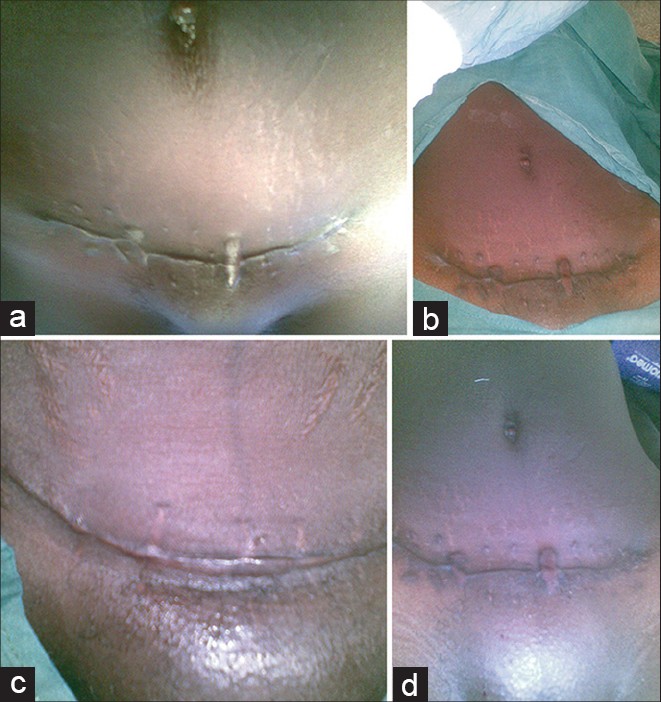|
 
 |
| LETTER TO EDITOR |
|
| Year : 2013 | Volume
: 15
| Issue : 1 | Page : 37-38 |
|
Could pfannenstiel incision for emergency caesarean section be associated with the development of uretero-vaginal fistula?
AJ Randawa1, A Muhammed2, L Khalid2
1 Department of Obstetrics and Gynaecology, Ahmadu Bello University/Ahmadu Bello University Teaching Hospital, Zaria, Nigeria
2 Department of Surgery, Ahmadu Bello University/Ahmadu Bello University Teaching Hospital, Zaria, Nigeria
| Date of Web Publication | 22-Sep-2014 |
Correspondence Address:
A Muhammed
Department of Surgery, Division of Urology, Ahmadu Bello University Teaching Hospital, Zaria, Kaduna
Nigeria
 Source of Support: None, Conflict of Interest: None  | Check |
DOI: 10.4103/1595-1103.141395

How to cite this article:
Randawa A J, Muhammed A, Khalid L. Could pfannenstiel incision for emergency caesarean section be associated with the development of uretero-vaginal fistula?. Niger J Surg Res 2013;15:37-8 |
How to cite this URL:
Randawa A J, Muhammed A, Khalid L. Could pfannenstiel incision for emergency caesarean section be associated with the development of uretero-vaginal fistula?. Niger J Surg Res [serial online] 2013 [cited 2017 Apr 5];15:37-8. Available from: http://www.njsrjournal.org/text.asp?2013/15/1/37/141395 |
Sir,
We made an unusual observation of the occurrence of uretero-vaginal fistula following emergency cesarean section in four consecutive patients, in whom Pfannenstiel incision was employed to gain access to the uterus. All the cesarean sections were done in rural hospitals and apparently by inexperienced surgeons. In all the patients [Figure 1]a-d, the incision scar was ragged and ugly, indicating healing by secondary intention, thus defeating the major goal of the incision, which is cosmesis. None of these patients had concurrent vesico-vaginal fistula (VVF). | Figure 1: (a-d) Show ragged scars of Pfannenstiel incisions for the four patients
Click here to view |
Pfannenstiel incision (described by Hermann Johannes Pfannenstiel in 1900) is a low transverse abdominal skin crease surgical incision about 2-3 cm above the pubic symphysis. The rectus abdominis muscles are separated along the linea alba and retracted laterally without cutting. [1],[2] It produces an aesthetically more pleasing "bikini-line" scar, thus it is often also called a "bikini-line incision. It is employed to access the pelvic organs including the uterus. Its main advantage is the cosmetic scar it produces which is desirable generally by women. It offers large view of central pelvis but limits exposure to the lateral extent of the pelvis and upper abdomen, a factor that limits its usefulness in gynecologic oncology surgery. [3] The limited access Pfannenstiel incision offers makes it difficult to perform certain pelvic surgeries including emergency cesarean section, especially if the situation is complicated by obstructed labor. In obstructed labor, the fetal head is deep in the pelvis, thus there may be the need to employ a wider incision in the lower segment of the uterus to deliver the fetal head. This may, in the hands of the inexperienced surgeons, poor operative field lighting and inadequate instruments, lead to inadvertent injury to the uterine vessels. In the surgeon's desperate attempt to secure hemostasis, deep stitches are applied blindly with resultant injury or ligation of the pelvic ureter and subsequent development of uretero-vaginal fistula. [4],[5],[6] This was probably the case in these patients.
This observation questions the validity of using Pfannenstiel incision for emergency cesarean Section especially in the hands of the less experienced surgeon, as it may increase the risk of ureteric injury and subsequent development of uretero-vaginal fistula. There was no obvious obstetric cause because none of the patients had VVF.
We call for caution in using Pfannenstiel incision as a routine in emergency cesarean section; surgeons should consider safety over aesthetics in choosing the appropriate incision. This is particularly so if the surgeon has limited experience and is working with an inexperienced assistant in a suboptimal operating theatre setting. Training and retraining of medical officers and surgeons must be emphasized to avert this preventable complication.
| References | |  |
| 1. | Ayers JW, Morley GW. Surgical incision for cesarean section. Obstet Gynecol 1987;70:706-8. 
|
| 2. | Luijendijk RW, Jeekel J, Storm RK, Schutte PJ, Hop WC, Drogendijk AC, et al. The low transverse Pfannenstiel incision and the prevalence of incisional hernia and nerve entrapment. Ann Surg 1997;225:365-9. 
|
| 3. | Giacalone PL, Daures JP, Vignal J, Herisson C, Hedon B, Laffargue F. Pfannenstiel versus Maylard incision for cesarean delivery: A randomized controlled trial 2002. 
|
| 4. | Sorinola O, Murthy VN, Nallaswamy V, Srivastava S. Urinary tract injuries at caesarean section: Prevention and management. Br J Hosp Med (Lond) 2006;67:456-9. 
|
| 5. | Valgeirsdottir H, Hardardottir H, Bjarnadottir RI. Complications of cesarean deliveries. Laeknabladid 2010;96:37-42. 
|
| 6. | Sorinola O, Begum R. Prevention and management of ureteric injuries. Hosp Med 2005;66:329-34. 
|
[Figure 1]
|